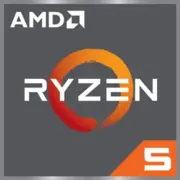AMD Ryzen 5 5625C

AMD Ryzen 5 5625C: A Processor for Mobility and Efficiency
March 2025
Introduction
AMD's Ryzen 5000 series notebook processors have proven their competitiveness in the thin and light device segment. The Ryzen 5 5625C, introduced in 2023, remains relevant in 2025 thanks to a successful balance of performance and energy efficiency. In this article, we will analyze who this chip is suitable for, how it handles tasks, and what to pay attention to when choosing a laptop.
Architecture and Technology Process
Zen 3 and 7nm: The Foundation of Stability
The Ryzen 5 5625C is based on the Zen 3 architecture (codename Cezanne-U) using the TSMC 7nm FinFET technology process. This provides:
- 6 cores and 12 threads with a base clock speed of 2.3 GHz and a turbo boost of up to 4.3 GHz.
- 16 MB of L3 cache — double that of the previous generation Ryzen 5 5500U, accelerating the processing of multi-threaded tasks.
- Integrated AMD Radeon Graphics with 7 compute units (CUs) and a frequency of up to 1.8 GHz.
iGPU Features:
- Support for DirectX 12 and VRAM up to 2 GB (allocated from system memory).
- Ability to output to 4K monitors at 60 Hz.
- Power-saving technologies like Radeon Chill (automatic FPS reduction in static scenes).
Power Consumption and TDP
15 W: A Balance Between Power and Longevity
The standard thermal design power (TDP) of 15 W allows the processor to be installed in ultrabooks and compact laptops.
- In idle mode, power consumption drops to 3–5 W thanks to AMD SenseMI technology.
- Under peak loads (e.g., video rendering), the chip can temporarily consume up to 25 W, but the cooling system quickly brings it back to normal levels.
Example: In the Lenovo Yoga 7 (2025) laptop with a 60 Wh battery and Ryzen 5 5625C, web surfing can last 10–12 hours.
Real-World Performance
Office and Multimedia
- Office Applications (Microsoft 365, Google Workspace):
- Loading 12 threads allows smooth multitasking across numerous browser tabs, Excel sheets, and video conferences without lag.
- In the PCMark 10 test, the processor scores 4800–5000 points — sufficient for most corporate tasks.
- Multimedia:
- Converting a 30-minute video to 1080p (HandBrake) takes 14–16 minutes.
- Photo editing in Lightroom is smooth, but working with 4K footage in Premiere Pro requires a discrete GPU.
Gaming
- Integrated graphics handle games at low to medium settings:
- CS2: 60–70 FPS (1080p, low settings).
- Genshin Impact: 40–45 FPS (720p).
- Fortnite: 50–55 FPS (900p, medium settings).
- Turbo mode (Precision Boost 2) automatically increases CPU frequency up to 4.3 GHz, but its effect in gaming is minimal — the GPU remains the bottleneck.
Use Cases
Ideal Choice for:
1. Students and Office Workers — Fast document processing, Zoom meetings.
2. Digital Nomads — Long battery life and support for USB4 for peripheral connectivity.
3. Casual Gamers — Games from indie projects or older AAA titles.
Not Suitable For:
- Professional 3D modeling.
- High-quality game streaming.
Battery Life and Power-Saving Technologies
How to Extend Battery Life?
- AMD PowerNow! dynamically adjusts CPU/GPU frequencies based on workload.
- Modern Standby — instant wake from sleep mode (like smartphones).
- In models with OLED screens (e.g., ASUS ZenBook 14X), the processor saves up to 20% of the charge thanks to adaptive synchronization with the display's refresh rate.
Tip: Choose laptops with a battery of at least 50 Wh and an IPS screen (not OLED) for maximum battery life.
Comparison with Competitors
AMD vs Intel vs Apple
1. Intel Core i5-1335U (15 W, 10 cores, 12 threads):
- Better for single-thread tasks (Geekbench 6 Single-Core: 1450), but lags in multi-threaded performance (Geekbench 6 Multi-Core: 4700).
- Integrated Iris Xe graphics are weaker than Radeon by 15–20%.
2. Apple M2 (8 cores, 10 W):
- Leader in energy efficiency (up to 18 hours of battery life in MacBook Air).
- Incompatibility with Windows and limited software choices for professional tasks.
3. Previous Generation AMD (Ryzen 5 5500U):
- Ryzen 5 5625C is 12–18% faster due to Zen 3 architecture and increased cache.
Pros and Cons of Ryzen 5 5625C
Strengths:
- Energy efficiency + support for USB4 and Wi-Fi 6.
- Notable multi-threaded performance for its price.
- Good integrated graphics for less demanding games.
Weaknesses:
- Maximum frequency is lower than that of the Intel Core i5-1335U.
- Budget laptops often come with slow SSDs and 8 GB of RAM, which bottleneck the CPU.
Recommendations for Laptop Selection
1. Device Type: ultrabooks (Acer Swift 3, HP Pavilion Aero) or convertibles (Lenovo Yoga 7).
2. RAM: at least 16 GB LPDDR4X (for working with virtual machines or graphics).
3. Storage: NVMe SSD starting at 512 GB (e.g., Samsung PM9B1).
4. Screen: Full HD+ resolution, 60 Hz refresh rate — higher isn't necessary due to iGPU limitations.
Budget: Laptops with Ryzen 5 5625C range from $650 to $900. For this price, you can find models with a metal chassis and a 2-year warranty.
Final Conclusion
AMD Ryzen 5 5625C is an optimal choice for those seeking an affordable yet reliable laptop for study, work, and light entertainment. Its key advantages include:
- Long battery life even in active use.
- Competence in moderate multitasking workloads.
- Support for modern connectivity standards.
This processor falls short compared to top chips in performance but excels in terms of price-to-quality ratio. If you don't need a discrete GPU and prioritize portability over power — Ryzen 5 5625C is the right choice for you.
Basic
CPU Specifications
Memory Specifications
GPU Specifications
Miscellaneous
Benchmarks
Compared to Other CPU
Share in social media
Or Link To Us
<a href="https://cputronic.com/en/cpu/amd-ryzen-5-5625c" target="_blank">AMD Ryzen 5 5625C</a>